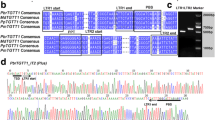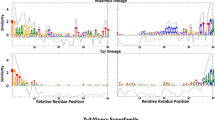Abstract
Plants, as most eukaryotic organisms, harbor several genes encoding a reverse transcriptase domain. The majority of them are part of transposable elements (TEs) and/or retroviral genomes that have been inserted into their genomes. However, there are some examples of RT domain-containing genes that have been endogenized during plant evolution; these genes appear to display functions other than “selfish” maintenance and replication of TEs, and subjected to host gene regulation. In the present work we have analyzed a subset of genes in Arabidopsis with an RT domain (RVT) containing a zinc finger motif (Znf), termed RVT-Znf domain, with structural characteristics of endogenous genes i.e., contain potential upstream regions as well as 5’UTR, and 3’UTR, and are not flanked by retroelement features. Phylogenetic analysis of these genes, based on the RVT-Znf domain, indicates that there are three clades, the members of which having additional domains. When compared to additional sequences, RVT-Znf formed a cluster that is more closely related to non-LTR retrotransposons and group II introns. Extant data from microarray databases indicate that several Arabidopsis genes are expressed. These data indicate that these RTs may have been endogenized. Possible roles for these genes are discussed.
Similar content being viewed by others
References
Bennetzen J. 2005. Transposable elements, gene creation and genome rearrangement in flowering plants. Curr. Opin. Genet. & Dev. 15: 621–627. doi: 10.1016/j.gde.2005.09.010.
Bundock P. & Hooykaas P. 2005. An Arabidopsis hAT-like transposase is essential for plant development. Nature 436: 282–284. doi: 10.1038/nature03667.
Creasey K.M., Zhai J., Borges F., Van Ex F., Regulski M., Meyers B.C. & Martienssen R.A. 2014. miRNAs trigger widespread epigenetically activated siRNAs from transposons in Arabidopsis. Nature 508: 411–415. doi: 10.1038/nature13069.
Crooks G.E., Hon G., Chandonia J.M. & Brenner S.E. 2004. WebLogo: A sequence logo generator. Genome Res. 14: 1188–1190.
Duan K., Ding X., Zhang Q., Zhu H., Pan A. & Huang J. 2008. AtCopeg1, the unique gene originated from AtCopia95 retrotransposon family, is sensitive to external hormones and abiotic stresses. Plant Cell Rep. 27:1065–1073. doi: 10.1007/s00299-008-0520-2.
Felsenstein J. 1985. Confidence Limits on Phylogenies: An Approach Using the Bootstrap. Evolution 39: 783–791. doi: 10.2307/2408678.
Feschotte C., Jiang N. & Wessler S. 2002. Plant transposable elements: where genetics meets genomics. Nat. Rev. Genet. 3: 329–341. doi: 10.1038/nrg793.
Feschotte C. 2008. Transposable elements and the evolution of regulatory networks. Nat. Rev. Genet. 9: 397–405. doi: 10.1038/nrg2337.
Gouy M., Guindon S., Gascuel O. 2010. SeaView version 4: a multiplatform graphical user interface for sequence alignment and phylogenetic tree building. Mol. Biol. Evol. 27: 221–224. doi: 10.1093/molbev/msp259.
Grandbastien M.A. 2015. LTR retrotransposons, handy hitchhikers of plant regulation and stress response. Biochim. Biophys. Acta 1849: 403–416. doi: 10.1016/j.bbagrm.2014.07.017.
Hruz T., Laule O., Szabo G., Wessendorp F., Bleuler S., Oertle L. et al. 2008. Genevestigator V3, a reference expression database for the meta-analysis of transcriptomes. Adv. Bioinformatics 2008: 420747. doi: 10.1155/2008/420747.
Huang C.R., Burns K.H., Boeke J.D. 2012. Active transposition in genomes. Annu. Rev. Genet. 46: 651–675. doi: 10.1146/annurev-genet-110711-155616.
Hua-Van A., Le Rouzic A., Maisonhaute C., Capy P. 2005. Abundance, distribution and dynamics of retrotransposable elements and transposons: similarities and differences. Cytogenet. Genome Res. 110: 426–440. doi: 10.1159/000084975.
Hudson M., Lisch D. & Quail P. 2003. The FHY3 and FAR1 genes encode transposase related proteins involved in regulation of gene expression by the phytochrome A-signaling pathway. Plant J. 34: 453–471. doi: 10.1046/j.1365-313X.2003.01741.x.
Keren I., Bezawork- Geleta A., Kolton M. Maayan I., Belausov E., Levy M., Mett A., Gidoni D., Shaya F., & Ostersetzer-Biran O. 2009. AtnMat2, a nuclear-encoded maturase required for splicing of group-II introns in Arabidopsis mitochondria. RNA 15: 2299–2311. doi: 10.1261/rna.1776409.
Larkin M.A., Blackshields G., Brown N.P., Chenna R., McGettigan P.A., McWilliam H., Valentin F., Wallace I.M., Wilm A., Lopez R., Thompson J.D., Gibson T.J. & Higgins D.G. 2007. Clustal W and Clustal X version 2.0. Bioinformatics 2321: 2947–2948.
Lisch D. 2013. How important are transposons for plant evolution? Nat. Rev. Genet. 141: 49–61. doi: 10.1038/nrg3374.
Lucas W.J., Groover A., Lichtenberger R., Furuta K., Yadav S.-R., Helariutta Y., He X.Q., Fukuda H., Kang J., Brady S.M., Patrick J.W., Sperry J., Yoshida A., López-Millán A.F., Grusak M.A. & Kachroo P. 2013. The Plant Vascular System: Evolution, Development and Functions. J. Integr. Plant Biol. 55: 294–388. doi: 10.1111/jipb.12041.
Nakamura T. & Cech T. 1998. Reversing Time: Origin of Telomerase. Cell 92: 587–590. doi: 10.1016/S0092-86740081123-X.
Oliver K. & Greene W. 2008. Transposable elements: powerful facilitators of evolution. BioEssays 31:703–714. Doi: 10.1002/bies.200800219.
Oliver K., McComb J. & Greene W. 2013. Transposable Elements: Powerful Contributors to Angiosperm Evolution and Diversity. Genome Biol. Evol. 5: 1886–1901. doi: 10.1093/gbe/evt141.
Ruiz-Medrano R., Xoconostle-Cázares B., Ham B., Li G. & Lucas W.J. 2011. Vascular expression in Arabidopsis is predicted by the frequency of CT/GA rich repeats in gene promoters. Plant J. 67: 130–144. doi: 10.1111/j.1365-313X.2011.04581.x.
Tamura K., Stecher G., Peterson D., Filipski A. & Kumar S. 2013. MEGA6: Molecular Evolutionary Genetics Analysis version 6.0. Mol. Biol. Evol. 30: 2725–2729.
Vicient C.M., Jääskeläinen M.J., Kalendar R. & Schulman A.H. 2001. Active retrotransposons are a common feature of grass genomes. Plant Physiol. 125: 1283–1292.
Volff J.N. 2006. Turning junk into gold: domestication of transposable elements and the creation of new genes in eukaryotes. BioEssays 28: 913–922.
Wang W., Zheng H., Fan C., Li J., Shi J., Cai Z., Zhang G., Liu D., Zhang J., Vang S., Lu Z., Wong G.K., Long M. & Wang J. 2006. High rate of chimeric gene origination by retroposition in plant genomes. Plant Cell 18: 1791–1802. doi: 10.1105/tpc.106.041905.
Wessler S. 1996. Plant retrotransposons: Turned on by stress. Curr. Biol. 6: 8 959–961.
**ong Y. & Eickbush T.H. 1990. Origin and evolution of retroelements based upon their reverse transcriptase sequences. EMBO J. 9: 3353–3362.
Yamasaki K., Kigawa T., Inoue M., Watanabe S., Tateno M., Seki M., Shinozaki K. & Yokoyama S. 2008. Structures and evolutionary origins of plant-specific transcription factor DNAbinding domains. Plant Physiol. Biochem. 46: 394–401. doi: 10.1016/j.plaphy.2007.12.015.
Zhao M. & Ma J. 2013. Co-evolution of plant LTR-retrotransposons and their host genomes. Protein Cell 47: 493–501. doi: 10.1007/s13238-013-3037-6.
Zimmermann P., Hirsch-Hoffmann M., Hennig L. & Gruissem W. 2004. GENEVESTIGATOR. Arabidopsis Microarray Database and Analysis Toolbox. Plant Physiol. 136: 2621–2632. doi: 10.1104/pp.104.046367.
Acknowledgements
This work was supported by CONACyT-México grants Nos. 109885 (to BX-C) and 156162 (to RR-M). SVG-G and ACM-N acknowledge doctoral fellowship support from CONAcyT.
Author information
Authors and Affiliations
Corresponding author
Electronic supplementary material
Rights and permissions
About this article
Cite this article
Galván-Gordillo, S.V., Concepción Martínez-Navarro, A., Xoconostle-Cázares, B. et al. Bioinformatic analysis of Arabidopsis reverse transcriptases with a zinc-finger domain. Biologia 71, 1223–1229 (2016). https://doi.org/10.1515/biolog-2016-0145
Received:
Accepted:
Published:
Issue Date:
DOI: https://doi.org/10.1515/biolog-2016-0145




